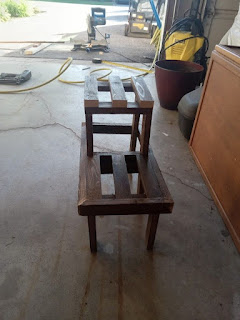June 20, 2024
Introduction
There's no denying the transformation a new coat of paint can bring to a house. But have you ever thought about the deft hand that brought about that change? Painting houses is a fulfilling line of work that combines creative problem-solving, physical exertion, and the joy of making homes look beautiful. Aspiring painters can start their journey towards becoming successful housepainters with the knowledge and techniques provided in this comprehensive guide.
 |
| Here is an example of a wall well painted |
Building the Foundation
Any successful career, including house painting, must have a solid foundation. We'll lay out the fundamental abilities and information you'll need here to get going.
Mastering the Tools of the Trade: Familiarize yourself with various brushes, rollers, and applications. Learn about their functionalities and how they interact with different paint types (acrylic latex, oil) Click here for more information. Understanding painter's tape, drop cloths, and surface preparation tools is equally important.
-
Surface Savvy: Distinguish between various surfaces commonly encountered in house painting—drywall, wood, stucco, and masonry. Research the appropriate preparation techniques for each surface, including cleaning, sanding, patching, and priming Click Here for More information.
-
Colour Confidence: A fundamental understanding of colour theory is crucial. Learn about primary and secondary colours, the colour wheel, and how to create harmonious palettes. Consider factors like natural lighting and desired ambiance when selecting paint colours for clients Click here for more details.
Developing Technical Expertise
After laying the groundwork, let's get into the specifics that will improve your house painting abilities:
Preparation Perfection: Proper surface preparation is paramount for a flawless and long-lasting paint job. Master techniques like scraping, sanding, caulking, and applying primer to ensure a smooth, even surface for paint application.
-
Brushwork Brilliance: Learn proper brush handling techniques to achieve clean lines, smooth coverage, and minimize drips and splatters. Practice cutting in (painting edges where brush meets wall) and rolling techniques for efficient and even paint application.
-
The Art of the Roller: Mastering roller techniques is essential for covering large areas efficiently. Learn about different roller nap sizes and their suitability for various textures. Practice maintaining a consistent pressure and applying paint in smooth, overlapping strokes.
-
Drop Cloth Dexterity: Protecting furniture, floors, and landscaping is crucial. Learn how to effectively use drop cloths and painter's tape to create a clean work area and minimize cleanup.
-
Safety First: House painting involves working at heights and with potentially hazardous materials. Familiarize yourself with safety regulations and proper use of ladders, scaffolding, and personal protective equipment (PPE) like gloves, respirators, and safety glasses.
 |
| One of the rooms I painted |
Cultivating Your Craft
- Beyond technical proficiency, the following qualities are essential to develop for a lucrative career in house painting:
Business Basics: Look up the local requirements for licenses. You should think about getting liability insurance to safeguard both you and your clients. Find out how to estimate projects, set competitive prices for your services, and draft precise contracts.
-
Customer Communication: It's essential to have excellent communication skills. Pay attention to the wants, needs, and financial limitations of your clients. Give concise justifications of the painting procedure, project schedules, and anticipated results.
-
Professionalism is Key: Reliability, timeliness, and a spotless work ethic are crucial for earning clients' trust and gaining their business again. Arrive on time, present yourself professionally, and leave the workspace tidy and orderly.
-
Continuing Education: Keep abreast of the most recent developments and trends in the house painting sector. Investigate novel methods, paints, and safety measures to improve the services you provide.
-
Building Your Brand: Establish a solid online presence by displaying your work and client endorsements on a business website or social media profiles. Word-of-mouth advertising is still very effective; give outstanding customer service to make sure happy customers tell others about you.
Conclusion
It takes commitment, practice, and a love of remodelling spaces to become an excellent house painter. You can build a fulfilling career in this fast-paced industry by becoming proficient in the fundamentals, expanding your technical knowledge, and adopting a professional demeanour. Accept the process of learning, keep improving as a professional, and you'll see your reputation as a knowledgeable and trustworthy house painter grow.
All the Best,
Joseph Botelho
We appreciate you visiting our site and your comments on our subjects. Subscribe to our blog to get a copy of "Repair Smart: Money-Saving Maintenance Hacks for Homeowners." This ebook offers practical advice on how to control expenses for your do-it-yourself house renovations. Simply leave a comment to request a free copy of our ebook.
Request a complimentary copy of this ebook. |





















